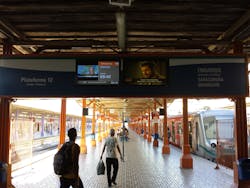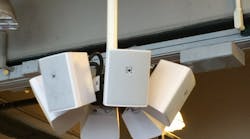It’s no secret that the world is becoming more crowded each and every day. Nowhere is this more evident than in our cities. Urban density is a concept that is no longer confined to places like New York, London or Tokyo. Across the planet, a range of cities like Portland in the United States, Melbourne in Australia and a long list of second- or third-tier cities in China are wrestling with a set of seemingly impossible challenges.
How can a city accommodate more people without adding sprawl? How can a metropolitan area that is growing rapidly either maintain or decrease its negative impact on the environment? Congestion is often cited as a major factor in determining which cities across the globe are considered the least desirable places to live and work. Is it possible for a city to be home to a large number of individuals, families and businesses without becoming congested?
Public transit has the potential to address all of those challenges and more. An obvious example is New York. Imagine if every person riding the subway in the metropolitan area drove a car instead? The ratio of people to road space make it imminently clear that it simply would not work. A less obvious example – at least to those of us who do not live there – is the transit system in Salt Lake City. In an area known for inversions, reducing the number of cars on the road literally makes the air easier to breathe, which is of critical importance to a corridor of cities and towns that comprise one of the country’s fastest growing metropolitan areas.
Unfortunately, enlisting public transit in the quest to better manage urban areas fares better on paper than in reality. And one of the main reasons for that is public transit’s reputation, which is, in a word, scary. Images of a defenseless individual stranded on an abandoned subway platform late at night abound in the public imagination. A quick look at the headlines, whether in print or online, reinforces those fears with a healthy and never-ending stream of stories about shady characters who routinely menace anyone daring enough to venture out of the safety of her car and into the realm of public transit.
"The Human Touch"
The unfamiliarity of public transit is one of the main reasons that people tend to be afraid of it. Transforming a space that seems foreign into one that feels at once more familiar is one of the main ways that installing a high-quality system that integrates audio and signage capabilities can help public transit appeal to more citizens and ultimately increase ridership.
There are many ways that improving audio and signage functions can enhance the commuter’s overall experience.
At the most basic level, increasing the quality of the sound in which a human voice makes an announcement and then having that announcement reiterated in the form of timely and clear visual alerts creates an environment that simply feels more lively and active. That, in turn, can help allay the security concerns of existing public transit users while also helping to attract new ones, particularly during off-peak hours and at transit stations in less-than-desirable neighborhoods.
Closely related, being able to communicate information clearly and quickly to a large number of riders helps establish a higher level of trust between the individual and the system, one that must begin with each commuter feeling that she is being informed. This is certainly beneficial on a typical day, but it becomes particularly important when critical information needs to be conveyed during an emergency.
Integrated Audio
When selected and deployed correctly, an investment in quality audio solutions that are integrated with automated signage can yield benefits that go beyond the realm of communications. This is particularly important as cities and regions grapple with unprecedented fiscal challenges that often put upgrades to the physical environment on the back burner.
Available at a price point that doesn’t result in a political liability more politely known as sticker shock, a carefully designed system consisting of sophisticated components has the potential to infuse an aging infrastructure with new vitality in many ways.
In an increasingly mobile society, the cultural and linguistic blueprint of the globe is shifting, and nowhere is that more apparent than in our cities. The dramatic rise in migration nearly everywhere in the world make it necessary for messages to be conveyed in more than one language. While it wouldn’t be feasible to have a native speaker of each dominant language represented, it is feasible – and efficient – to have one multi-lingual transit employee make announcements, and let the technology translate the voice into written form on screens throughout the system.
In addition to needing to serve commuters who listen and read in different languages, today’s transit systems must take into consideration the increase in the number of differently abled individuals fully participating in all the elements of daily life a city has to offer.
Integrated audio and signage solutions benefit a city’s infrastructure in ways that go behind serving commuters with a wider variety of demographic backgrounds.
Public address systems with integrated signage functionality that draw on powerful technology can be more easily and affordably extended to serve more commuters in more places. There are solutions on the market, in fact, that require only minor modifications in order to extend the technology to other locations, where it is often able to “talk” with a wide variety of legacy equipment. What that means for a transit authority is the ability to deliver the value of a public investment to a far greater number of constituents.
Finally, one of the most significant benefits of an audio system with integrated signage functionality isn’t obvious today. New technology is being developed more rapidly than ever before, and the speed at which innovation happens only continues to increase. The more technologically advanced your system is today, the more likely it will be able to interact with innovative technology that will be introduced in the future. The system you’re about to deploy to handle announcements and signage may, in the near future, interact in new and currently inconceivable ways with the commuters who rely on your city’s mass transit each and every day. Don’t let them down.
Real-World Results
There are examples from around the world of the potential an integrated public address and signage solution has to dramatically improve a transit system’s operations without dramatically increasing its budget — or its debt.
A particularly compelling example is one of the most extensive transit systems in the world; one that’s been carrying passengers for nearly 120 years and has more than 450 stations — the New York City subway system. While the entire system shows its age — it’s hard not to, at 120 — there was one terminal in particular where the wear and tear of the decades was unusually visible, the Stillwell Avenue Terminal. This building had, since opening in the 1920's, endured everything thrown its way by its next-door neighbor, the Atlantic Ocean. In more recent years the building had also succumbed to the financial hardships suffered by the entire area and had fallen into such a state of disrepair that it was torn down and rebuilt in 2006 with an eye toward innovation. Today, with 60 percent of the terminal’s power generated by solar power, the terminal is the most energy-efficient mass transit station in the U.S. Equally innovative, it’s also home to a system from Harman that combines audio capabilities with a software-based communications system.
At the heart of the solution is integrated loudspeaker, amplifier and network hardware with communications software and digital signage screens for messaging. The terminal serves as the starting point for four lines, which requires data about arrivals, departures, delays and other factors to be conveyed to the 82 stations served by the trains that originate at the terminal. While sound quality varies from station to station due to architectural elements, most were built with concrete and tile, which creates more reverberation and distortion than what’s typically present in more acoustically friendly environments. Therefore, the solution chosen needed to be able to integrate with the legacy systems used in many of the stations. Components needed to be able to withstand high temperatures and a lot of steel dust. Finally, since this system operates 24/7, the project needed to be completed from start to finish without taking a single train out of service.
High quality loudspeakers were only the beginning: Seamlessly communicating data such as announcements about arrivals, departures, delays and other train-related information was equally important. That’s what drove the selection of a hardware-software solution that takes the audio components and combines them with the information delivery system in order to create a digital display of audio updates. The delivery system extends the deployment to each of the stations served by the four lines that originate at the terminal. While the old technology was limited to just two platforms and the mezzanine, the new system extends the communications to an unlimited number of logical zones, making it possible to fine tune the system according to the requirements of any of the stations served by the four lines that originate at the terminal. With the ease of a simple software change, for example, configurations can be adjusted in order to deal with the variance of acoustical and architectural factors at each station to achieve a much higher level of speech intelligibility. While the old system offered two options – all or nothing – the new technology makes it easy to program details such as the volume at which announcements are played throughout the day and night at stations located in predominately residential neighborhoods. The system allows the terminal to interface to old analog carrier systems along the lines that originate at the terminal, making it easy to communicate with all the local control stations on all of those lines.
Perhaps most importantly, the system lays the groundwork for expansion in the future. According to the transit system’s employee who oversaw the project, as a proof of concept, this is a home-run.
Blake Augsburger is president at Harman Professional Solutions Division.




